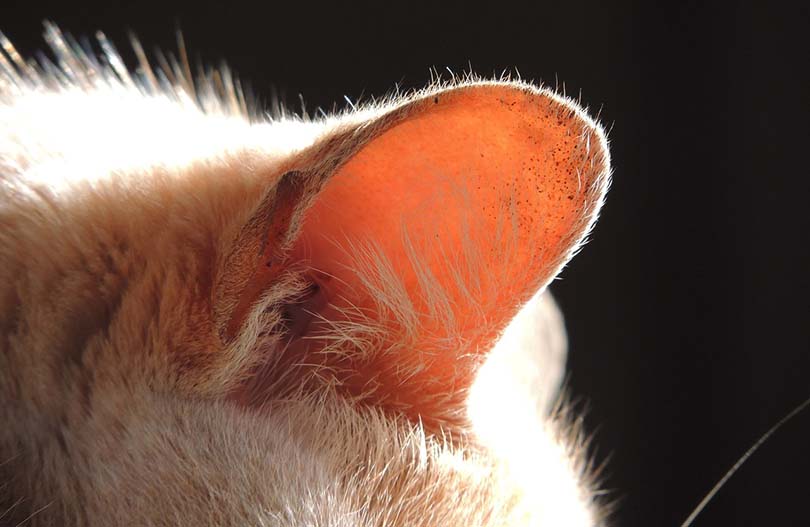Click to Skip Ahead
Dogs and cats are two of the most popular pets in America and are beloved for their unique personalities and strengths. There are some ways that dogs and cats are similar, such as their unconditional love for their favorite humans, and some ways that they are different, such as dogs tending to be peppy while cats tend to be aloof. However, when it comes to the strength of their hearing, how do dogs and cats compare? Can dogs really hear better than cats? The answer may surprise you; dogs cannot hear better than cats. In fact, it’s the other way around.
Comparing Different Animals’ Hearing Ranges
Cats have a hearing range of 45–85,000 Hz. It is one of the broadest hearing ranges of any land mammal in the world. While dogs also have an impressive hearing range, it can’t compete with the cat’s superb hearing ability. For comparison, check out the chart below.
| Animal | Approximate Hearing Range |
| Cats | 45–85,000 Hz |
| Dogs | 67–45,000 Hz |
| Humans | 64–23,000 Hz |
| Rabbit | 360–42,000 Hz |
| Bat | 2,000–110,000 Hz |
| Guinea Pig | 150–50,000 Hz |
| Beluga Whale | 1,000–123,000 Hz |

The 5 Fun Facts About Your Dog’s Hearing Abilities
While a dog may not be able to hear as well as a cat, that doesn’t mean their auditory abilities are anything to scoff at. Our canines have excellent senses and impressive ears, which is evidenced by these five fun facts about canine hearing.
1. Dogs Can Hear Sounds from Far Away
Not only can dogs hear a wide range of sounds, but they can hear sounds across long distances. Some dogs have been reported to hear sounds from nearly a mile away.
This long range of hearing can explain why your canine companion is much more nervous about distant fireworks or thunderstorms. To you, these faraway sounds appear muffled. To your dog, those sounds are as clear as day!

2. Dogs Have Lots of Muscles in Their Ears
One of the reasons that dogs can hear so well is due to the abundance of muscles in their ears. Dogs have over a dozen muscles in their ears, allowing them to lift, tilt, and rotate their ears to capture a sound fully.
3. Dogs Are Geared to Hear High-Pitched Sounds
The wolf is one of the principal ancestors of the modern-day dog. As a predator, the wolf is built to hear the slightest squeaks that could indicate the presence of nearby prey. Since the wolf is a part of your dog’s heritage, your pet also has the ability to hear high-pitched sounds that humans cannot.

4. Dogs Can Predict Different Events with Their Excellent Hearing
Since your dog’s hearing is so sensitive, he can hear things and anticipate the outcome. Have you ever wondered how your dog knows to run to the front door long before you open it to step inside? Likely, he can hear the approach of your car long before you even pull into the driveway. Similarly, dogs have been known to predict earthquakes due to their sensitive hearing.
5. Dogs Can Detect Differences in Frequencies
If only dogs could play instruments, they might be the world’s best musicians. This is because dogs can detect the smallest of differences in frequencies. A dog’s hearing is so acute that he can detect the difference between a musical note C and a similar note that is only off by ⅛ of the distance between that same note and C sharp.

The 5 Facts About Your Cat’s Hearing Abilities
If you thought the dog’s keen sense of hearing was impressive, wait until you learn about your cat’s ears. Since a cat’s hearing range is much greater than a dog’s, their ears are unique, powerful, and fascinating.
1. Cats Have Many Muscles in Their Outer Ears
A human’s outer ear contains six muscles, but a feline’s ear has 32! But why does your cat have so many muscles in one little area?
The answer is simple; these muscles allow your cat to hear sounds much more clearly around them. Cats can rotate their ears around their heads, allowing them to pick up on even the faintest sounds.

2. Cats Are Born Deaf
For animals with such tremendous hearing, it is hard to believe that every one of them was born deaf. Surprisingly, all kittens are born with closed ear canals, meaning that sound cannot be transmitted to the eardrum. The ear canal doesn’t open until around 1 week of age, so until then, your kitten is entirely deaf.
3. Cat Ear Canals Are Typically Self-Cleaning
While dogs need regular ear cleaning, that is not the case for your cat. Unless your veterinarian specifically instructs you to clean your cat’s ears, it is best to leave his ears alone.

4. Cats Have a Mysterious Structure on Their Outer Ear
Have you ever noticed a thin flap of skin near your cat’s outer ear? If you have, you may have wondered about its purpose. Unfortunately, we don’t have an answer for you, as the purpose of that structure is largely unknown.
The skin flap is known as Henry’s pocket or the cutaneous marginal pouch. This structure can be found in bats, weasels, and even some dogs, but its purpose isn’t known. Some theorize that the flap assists your cat in picking up high-pitched sounds.
5. Cats That Are White and Blue-Eyed Are Often Deaf
If you’ve ever seen a white-haired, blue-eyed cat, there’s an increased chance that the cat was also deaf. The gene most commonly associated with the white fur and blue eyes combination is also connected to the degeneration of the inner ear. While not all white-furred, blue-eyed cats are deaf, it is believed that as many as 85% suffer from hearing loss.

Do Cats Have a Better Sense of Smell Than Dogs?
We’ve already established that cats are superior in terms of hearing, but how do they match up to dogs in a scenting contest? While cats definitely have a better sense of smell than humans, with up to 200 million scent receptors, they are no competition for dogs. Dogs possess as much as 300 million scent receptors, allowing them to pick up on scents that most other creatures couldn’t dream of.
Do Cats Have a Better Sense of Sight Than Dogs?
When it comes to the ability to see, it can be difficult to determine which animal is best. There are some areas where a cat’s sense of sight is superior, but there are others where the dog is the clear victor. Cats have better binocular vision than dogs, which is a better ability to judge distance. On the other hand, dogs have superior peripheral vision.
However, in the end, the cat’s vision is still considered better. Cats have much more refined retinas than dogs, giving them more complex sight abilities to track faster movements. Likewise, your cat’s tapetum lucidum is larger than your dog’s, meaning that your cat can see better in the dark. So, while there are some visual areas that the dog excels, ultimately, the cat has an advantage here as well.
Final Thoughts
While cats may have a better sense of hearing than dogs, that doesn’t mean a dog’s hearing is subpar. Both animals have incredible senses that make a human’s senses look minimal in comparison. However, when comparing the sense of smell of the dog and the cat, the dog wins. So the next time you see your cat or dog tilting their ears, pay attention; there may be someone or something approaching.
Featured Image Credit: tortugadatacorp, Pixabay













